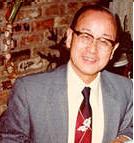
Ted Fujita (1920 – 1998)
On October 23, 1920, Japanese-American meteorologist Tetsuya Theodore Fujita was born. Fujita’s research at the University of Chicago on severe thunderstorms, tornadoes, hurricanes, and typhoons revolutionized the knowledge of each. In collaboration with Allen Pearson, head of the National Severe Storms Forecast Center/NSSFC , Fujita developed the Fujita scale (F-scale, Feb 1971) for measuring tornadoes on the basis of their damage.
Ted Fujita – Family Background and Education
Tetsuya Theodore Fujita was born in the village of Sone, Fukuoka Prefecture, Japan, an area that is now part of the city of Kitakyushu in northern Kyushu, the southwesternmost island in Japan. He was brought up in a small town; the native village of Nakasone which had about 1,000 people. His father, Tomojiro, passed away in 1939. According to his own account, Fujita stated that the last words of his father actually saved his life. He wanted to attend Hiroshima College but his father insisted that he attend Meiji College on Kyushu Island. Had Fujita attended Hiroshima College, he likely would have been killed by the first atomic bomb which exploded there in 1945.[1] At Meiji College he majored in Mechanical Engineering and graduated six months earlier than anticipated and soonafter was appointed as an assistant professor in physics.
Early “Weather Science”
Early in 1946, Fujita applied for a Department of Education grant under the topic “Weather Science”. In an effort to solve the mystery of unbalanced local winds at the surface, he wanted to observe the weather from a mountaintop. At a local weather station on a nearby mountain he was able to get complete records of wind, temperature and pressure from which he deduced that the thunderstorms contained a downward current of slightly cooler air. He was unaware at the time that the Thunderstorm Project was underway in the United States and had already measured such downdrafts.[1] For his doctorate degree Fujita was tasked with studying the damage in the wake of several typhoons which struck Kyushu Island three consecutive years in a row, which he completed successfully with the thesis “Analytical Study of Typhoons” in 1953.
Working in the USA
Being promoted to associate professor, Fujita was then invited to the University of Chicago on the invitation of Horace R. Byers who had become interested in his research, particularly his independent discovery of the cold-air downdraft.
The Fujita Scale
Fujita noticed a void between the Beaufort scale (B12) or 73 mph with the lower end of the Mach Number (M1) of 738 mph. So, he bridged the void with his own scale and divided it into 12 linear steps. He set aside the lowest six intervals F0 to F6 for rating tornado damage and called it the Fujita Tornado Scale, or F-scale. The F-scale linked wind speeds with corresponding damages to “strong frame houses”. The official Fujita scale category is determined by meteorologists and engineers after a ground or aerial damage survey, or both. Depending on the circumstances, ground-swirl patterns (cycloidal marks), weather radar data, witness testimonies, media reports and damage imagery, as well as photogrammetry or videogrammetry if motion picture recording is available. The F-Scale was replaced with the Enhanced Fujita scale (EF-Scale) in the United States in February 2007.
Further Research
Next to developing the Fujita scale, the meteorologist also became a pioneer in the development of tornado overflight and damage survey techniques, which he used to study and map the paths of the two tornadoes that hit Lubbock, Texas in 1970. Fujita established the value of photometric analysis of tornado pictures and films to establish wind speeds at various heights at the surface of tornado vortices. Further, Fujita was involved in developing the concept of multiple vortex tornadoes, which feature multiple small funnels (suction vortices) rotating within a larger parent cloud. His work established that, far from being rare events as was previously believed, most powerful tornadoes were composed of multiple vortices.
Later Life
In April 1974, the United States experienced the largest tornado outbreak since weather records began (Super Outbreak). The “Xenia (Ohio) Tornado” and the “Monticello (Indiana) Tornado” are still infamous today. Fujita and his students evaluated aerial photographs and two video camera recordings, which were still very rare at the time, and were thus able to prove that large tornadoes are often “danced around” by smaller funnels – and that houses in the tornado do not explode from the internal pressure, so that the previously obligatory opening of windows was pointless and cost valuable seconds to seek shelter. The extremely long-running “Monticello tornado” gave Fujita the idea of the “downburst” theory, which he could only prove years later.
After Fujita died, Storm Track magazine released a special November 1998 issue, “A Tribute To Dr. Ted Fujita” [1] and Weatherwise published “Mr. Tornado: The life and career of Ted Fujita” [3] as an article in its May/June 1999 issue.
Dr. Ted Fujita’s Presentation At The Third Tornado Symposium April 4, 1991, [5]
References and Further Reading:
- [1] Marshall, Tim; et al. (1998). “A Tribute to Dr. Ted Fujita”. Storm Track. 22 (1).
- [2] “A Tribute to the Works of T. Theodore Fujita”. Bulletin of the American Meteorological Society. American Meteorological Society. 82 (1). 1 January 2001.
- [3] Rosenfeld, Jeff (2 April 2010). “Mr. Tornado: The Life and Career of Ted Fujita”. Weatherwise. Taylor & Francis. 52 (3): 18–25.
- [4] Tetsuya Fujita, 78, Inventor of Tornado Scale. In: The New York Times. 21. November 1998
- [5] Dr. Ted Fujita’s Presentation At The Third Tornado Symposium April 4, 1991, vortexva @ youtube
- [6] Fujita, T. T., and Forbes, G. S., 1976f. Photogrammetric analysis of tornadoes, D. Three scales of motion involving tornadoes, in Peterson, R. E., ed., Proceedings of the Symposium on Tornadoes, Assessment of Knowledge and Implications for Man: Institute for Disaster Research, Texas Technological University, Lubbock, p. 53–57.
- [7] Ted Fujita at Wikidata
- [8] Timeline of American Academics of Japanese Descent, via Wikidata and DBpedia





